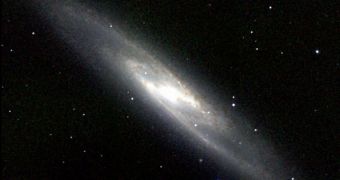A team of investigators has recently determined that galactic bars, the type of cosmic structure that can be found in the central areas of certain spiral galaxies, may play an important role in the destruction of galaxies as well.
The finding is very relevant because many spiral galaxies contain this type of structures. Their structure on galaxy development and evolution has never been quantified in evolution models before.
The investigation that led to this conclusion was carried out on data collected through the Galaxy Zoo 2 project, which seeks to analyze and classify as many galaxies as possible.
An association study conducted using these datasets has revealed the potential influence of bars. These structures are essentially made out of gas clouds and cosmic dust, but apparently they have a large influence on their surroundings.
During the original Galaxy Zoo project, participants were asked to associate images of galaxies with a standard classification, but in the second stage of the program, people are also encouraged to indicate whether the galaxies they are viewing have bars or not.
About 30 percent of all the spiral galaxies in the Universe are believed to have bars at their cores, and this is also the mean percentage that people participating in Galaxy Zoo 2 obtained.
Galaxy Zoo is an online astronomy project in which regular, minimally-trained citizens can participate. They are shown images of galaxies, while a menu on the right hand side asks them about what they see.
The structures are then classified automatically based on what the users are putting into the system. Some of the images are shown twice, so as to ensure that some don't skew the results by purposefully voting the wrong way.
In the new investigation, researchers at the University of Portsmouth, in the United Kingdom, looked at galaxies that both had and lacked a bar, and placed that in relation with other defining factors, such as color, bulge size, luminosity and so on.
One interesting correlation was made based on color. Younger, blue galaxies had less bars, on average, with only 20 percent of them displaying the features. On the other hands, about half of older, red galaxies had the bars.
“It’s not yet clear whether the bars are some side effect of an external process that turns spiral galaxies red, or if they alone can cause this transformation. We should get closer to answering that question with more work on the Galaxy Zoo dataset,” says Karen Masters.
She was the leader of the new investigation, and holds an appointment as a professor in the UP Institute of Cosmology and Gravitation, Universe Today reports.

 14 DAY TRIAL //
14 DAY TRIAL //